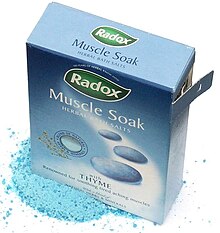Bath salts
This article is about salts used when bathing. For the designer drugs, see Bath salts (drug).
Bath salts are water-soluble, pulverised minerals that are added to water to be used for bathing. They are said to improve cleaning, enhance the enjoyment of bathing, and serve as a vehicle for cosmetic agents. Bath salts have been developed which mimic the properties of natural mineral baths or hot springs.
Description
The "salts" part of the name comes from their appearance being similar to the crystals of common salt.
Substances often labeled as bath salts include magnesium sulfate (Epsom salts), sodium chloride (table salt), sodium bicarbonate (baking soda), sodium hexametaphosphate(Calgon, amorphous/glassy sodium metaphosphate), sodium sesquicarbonate, borax, and sodium citrate.
Glycerin, or liquid glycerin, is another common ingredient in bath salts. Its health and beauty benefits allow it to be classified as an emollient, humectant or lubricant when used in bath salts products.
Fragrances and colors are often added to bath salts; in fact, one purpose of salts is as a vehicle or diluent to extend fragrances which are otherwise too potent for convenient use. Other common additives to bath salts are oils (agglomerating the salts to form amorphous granules, the product being called "bath beads" or "bath oil beads"), foaming agents, and effervescent agents.
Bath salts may be packaged for sale in boxes or bags. Their appearance is often considered attractive or appealing, and they may be sold in transparent containers, showing off, for example, the needlelike appearance of sodium sesquicarbonate crystals.
History
The earliest systematic exposition of the different kinds of salts, their uses, and methods of extraction was published in China around 2700 years BCE. Hippocrates encouraged his fellow healers to make use of salt water to heal various ailments by immersing their patients in sea water. The ancient Greeks continued this, and in 1753 English author and physician Charles Russel published "The Uses of Sea Water".
Effects
Some bath salts such as phosphates have a detergent action that softens calloused skin and aids in exfoliation. Some bath salts act as water softeners and change the way soap rinses. Some confusion may arise after a first experience with soft water. Soap does not lather well with hard water and can leave a sticky feeling. Soft water lathers better than hard water but feels slippery for a longer time during rinsing of soap, even though the soap is coming off faster, because the soap remains soluble.
High concentrations of salts increase the density of the water and increase buoyancy, which makes the body feel lighter in the bath. Very high concentrations of salts in water are used in many isolation tanktherapies. Researchers have also studied their use in treating arthritis.

No comments:
Post a Comment